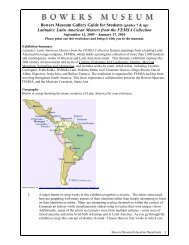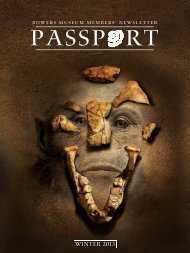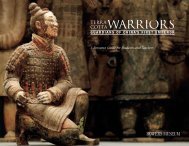Secrets of the Silk Road – Teacher Packet - Bowers Museum
Secrets of the Silk Road – Teacher Packet - Bowers Museum
Secrets of the Silk Road – Teacher Packet - Bowers Museum
Create successful ePaper yourself
Turn your PDF publications into a flip-book with our unique Google optimized e-Paper software.
elinquish, abandon" + makan, "place." Popular accounts define it as an area that means "go in and<br />
you will never come out".<br />
Tarim Basin<br />
The Tarim Basin is a large is enclosed drainage depression that retains water. It occupies an area <strong>of</strong><br />
more than 150,000 square miles. It is located in <strong>the</strong> Xinjiang Uyghur Autonomous Region in China's<br />
far west. Its nor<strong>the</strong>rn boundary is <strong>the</strong> Tian Shan mountain range and its sou<strong>the</strong>rn is <strong>the</strong> Kunlun<br />
Mountains on <strong>the</strong> nor<strong>the</strong>rn edge <strong>of</strong> <strong>the</strong> Tibetan Plateau. The Taklamakan Desert dominates much <strong>of</strong><br />
<strong>the</strong> basin. The people living in <strong>the</strong> area include <strong>the</strong> Uyghurs, <strong>the</strong> Tajiks, as well as o<strong>the</strong>r Turkic<br />
peoples. Early on, this area was occupied by <strong>the</strong> Xiongnu peoples, <strong>the</strong> Huns, <strong>the</strong> Wusun who lived<br />
in <strong>the</strong> pasturelands to <strong>the</strong> northwest <strong>of</strong> <strong>the</strong> Tarim, and <strong>the</strong> Yuexhi who eventually migrated from <strong>the</strong><br />
corridors <strong>of</strong> frontier China into <strong>the</strong> Persian Empire.<br />
The mummies <strong>of</strong> <strong>the</strong> Tarim Basin are one <strong>of</strong> <strong>the</strong> great finds <strong>of</strong> <strong>the</strong> 20 th century. They are not <strong>the</strong> byproducts<br />
<strong>of</strong> mummification methods practiced in Egypt, ra<strong>the</strong>r <strong>the</strong>y were buried in an arid<br />
environment and preserved by salty soil and cold winters.<br />
Early explorers and archaeologists <strong>of</strong> <strong>the</strong> area include:<br />
Sven Hedin (1865-1952)<br />
Aurel Stein (1862-1943)<br />
Albert von Le Coq (1860-1930)<br />
Paul Pelliot (1878-1945)<br />
Ǖrümchi [pronounced ewe-rum-shi] <strong>–</strong> also seen as Ürümqi<br />
Ürümchi is <strong>the</strong> capital <strong>of</strong> <strong>the</strong> Xinjiang Uyghur Autonomous Region <strong>of</strong> <strong>the</strong> People's Republic <strong>of</strong><br />
China, in <strong>the</strong> northwest <strong>of</strong> <strong>the</strong> country. Its name means “beautiful pasture” in <strong>the</strong> Mongolian<br />
language <strong>of</strong> <strong>the</strong> Dzungar people. With an urban population <strong>of</strong> over 2.3 million people, it is by far <strong>the</strong><br />
largest city on China's vast Western interior. Since <strong>the</strong> 1990s Ürümqi has become gradually<br />
developed economically and now serves as a regional transport and commercial center.<br />
Although Ǖrümchi, situated near <strong>the</strong> nor<strong>the</strong>rn route <strong>of</strong> <strong>the</strong> <strong>Silk</strong> <strong>Road</strong>, is a relatively young city, in AD<br />
648, Emperor Taizong (Tang Dynasty), established <strong>the</strong> town <strong>of</strong> Luntai, just a few miles away as a seat<br />
<strong>of</strong> local government to collect taxes from <strong>the</strong> caravans along <strong>the</strong> nor<strong>the</strong>rn route <strong>of</strong> <strong>the</strong> <strong>Silk</strong> <strong>Road</strong>.<br />
Little was heard <strong>of</strong> <strong>the</strong> region following <strong>the</strong> Tang Dynasty until <strong>the</strong> conquest <strong>of</strong> Dzungaria area in<br />
1755 under <strong>the</strong> Emperor Qianlong <strong>of</strong> <strong>the</strong> Qing Dynasty. The Dzungar people were deliberately<br />
exterminated in a brutal campaign <strong>of</strong> ethnic genocide. One writer, Wei Yuan, described <strong>the</strong> resulting<br />
desolation in what is now nor<strong>the</strong>rn Xinjiang as: "an empty plain for a thousand li, with no trace <strong>of</strong><br />
man." After 1759, state farms were established, "especially in <strong>the</strong> vicinity <strong>of</strong> Urumchi, where <strong>the</strong>re<br />
was fertile, well-watered land and few people.".<br />
In 1763, during <strong>the</strong> Qing Dynasty, <strong>the</strong> Qianlong Emperor named <strong>the</strong> expanded town <strong>of</strong> Luntai<br />
"Dihua," meaning "to enlighten." In 1884, <strong>the</strong> Guangxu Emperor established Xinjiang as a Province,<br />
with Dihua as its capital.<br />
The city was <strong>the</strong> site <strong>of</strong> major rioting in July 2009 due to conflicts between Han and Uyghur ethnic<br />
groups in which nearly 200 people were left dead; most <strong>of</strong> <strong>the</strong> victims were Han-Chinese. Reports <strong>of</strong><br />
extensive police retaliation against <strong>the</strong> Uyghur minority have circulated ever since, despite <strong>the</strong><br />
Chinese government having shut down access to emails and overseas phone calls.<br />
<strong>Bowers</strong> <strong>Museum</strong> Education Department<br />
March 2010<br />
24





